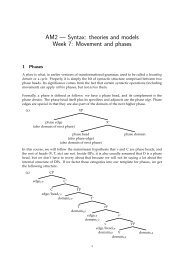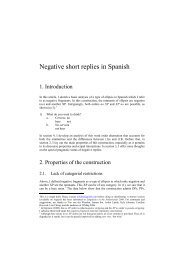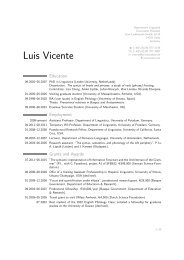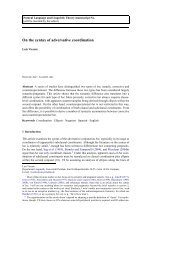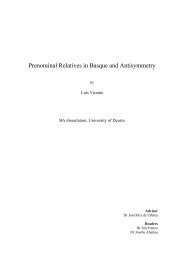Verb fronting in Mandarin Chinese - Luis Vicente
Verb fronting in Mandarin Chinese - Luis Vicente
Verb fronting in Mandarin Chinese - Luis Vicente
Create successful ePaper yourself
Turn your PDF publications into a flip-book with our unique Google optimized e-Paper software.
Cheng & <strong>Vicente</strong><br />
<strong>Verb</strong> <strong>front<strong>in</strong>g</strong> <strong>in</strong> Mandar<strong>in</strong><br />
UCSC L<strong>in</strong>guistics Colloquium<br />
October 31, 2008<br />
• A-bar movement of a bare verbal head, strand<strong>in</strong>g its complement (Koopman 1984; <strong>Vicente</strong> 2007).<br />
• Movement of √ P, below the level where the complement is merged (Harbour 1999; Landau 2006).<br />
M<strong>in</strong>or digression — how is this detected <strong>in</strong> other languages? Through morphological clues. For<br />
<strong>in</strong>stance, <strong>in</strong> Spanish, the shape of the topic is sensitive to voice alternations, which suggests that the<br />
mov<strong>in</strong>g constituent must be large enough to <strong>in</strong>clude at least the functional head responsible for voice<br />
(other languages have similar patterns for middle/<strong>in</strong>choative/causative/. .. morphology).<br />
(24) a. { ̌ Reparar<br />
fix.<strong>in</strong>f<br />
b. { * Reparar<br />
fix.<strong>in</strong>f<br />
/ * reparada }, Mauricio ha reparado la puerta<br />
fix.pass.3sg.fem Mauricio has fixed the door<br />
/ ̌ reparada }, la puerta ha sido reparada<br />
fix.pass.3sg.fem the door has been fix.pass.3sg.fem<br />
In Biblical Hebrew (Harbour 1999), the topic can appear <strong>in</strong> the default b<strong>in</strong>yan, irrespective of the<br />
b<strong>in</strong>yan of the lower copy. However, Modern Hebrew forces the topic to match the b<strong>in</strong>yan of the lower<br />
copy (Landau 2006). This means that BH allows copy<strong>in</strong>g of a bare root (below the level where the<br />
b<strong>in</strong>yan is determ<strong>in</strong>ed), whereas MH forces copy<strong>in</strong>g of a larger category.<br />
(25) w’attåh hu’ nåqoh t<strong>in</strong>nåqäh lo’ T<strong>in</strong>nåqäh<br />
and.thou he be.clean you.will.be.clean not you.will.be.clean<br />
“And are thou he who shall altogether go unpunished? Thou shall not go unpunished”<br />
[Biblical Hebrew, Jeremiah 49:12]<br />
(26) w’attem h<strong>in</strong>nåqeh T<strong>in</strong>nåqäh lo’ T<strong>in</strong>åqu<br />
and.you be.clean you.will.be.clean not you.will.be.clean<br />
“And should ye be utterly unpunished? Ye shall not be unpunished”<br />
[Modern Hebrew, same verse]<br />
S<strong>in</strong>ce Ch<strong>in</strong>ese has no <strong>in</strong>flectional morphology, this particular strategy is unavailable.<br />
2.3 Interim conclusion<br />
<strong>Verb</strong>al clefts require:<br />
• A-bar movement of a verbal constituent, but noth<strong>in</strong>g exceptional wrt syntax.<br />
• Spell out of two l<strong>in</strong>ks of this A-bar cha<strong>in</strong> (to be discussed <strong>in</strong> section 5).<br />
3 <strong>Verb</strong>al lian...dou<br />
3.1 Brief survey of lian...dou constructions<br />
Rough semantics — dou has occasionally been analyzed as a universal/distributive quantifier, but<br />
<strong>in</strong> reality it is a maximality operator (Xiang 2008; Cheng to app.b).<br />
(27) a. haizimen qu-le gongyuan<br />
children go.asp park<br />
“The children went to the park (although one or two didn’t)”<br />
6 of 13



